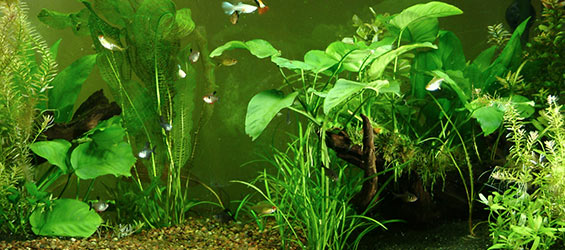
The two basic requirements for healthy aquarium plants are light and proper carbon dioxide (CO2) levels. Through a process called "photosynthesis," aquarium plants use light energy and CO2 to produce food necessary for lush growth. As plants develop, they use up their existing supply of carbon dioxide. Installing a CO2 system is essential to prevent low CO2 levels and to maintain active plant growth. These systems are available in three basic styles to ensure a healthy environment for planted aquariums of all sizes.
Manual CO2 Systems
Most manual CO2 systems are essentially yeast fermentation systems. CO2 is generated as a metabolic byproduct of yeast and stored within a fermentation canister. The accumulated carbon dioxide travels through a reaction chamber and is then mixed with the aquarium water by means of a diffuser or a powerhead. These systems are easy to use, budget-friendly, and well suited for smaller planted aquariums. Just as their name implies, these units must be turned on and off manually to maintain ideal CO2 levels within your aquarium.
Semi-automatic CO2 Systems
Semi-automatic CO2 systems involve a bit more effort to install initially, but are timer-operated to help simplify CO2 injection. A CO2 canister supplies carbon dioxide and the amount of CO2 entering the aquarium is controlled by a series of components, including a pressure regulator with solenoid, a bubble counter, and a CO2 diffuser. The timer-operated solenoid opens during a set period of time (i.e. when the lights are on) to supply plants with carbon dioxide. These systems are perfect for mid-size and larger planted aquariums that have a greater demand for CO2.
Examples of Semi-automatic Systems:
Question:
Do I need a CO2 system for my planted aquarium? |
Answer:
CO2 supplementation is usually contingent upon light intensity. In general, heavily planted aquariums with high output light fixtures will require a CO2 system to keep up with the greater plant demand for carbon dioxide. |
Automatic CO2 Systems
Automatic CO2 systems share many of the same features as semi-automatic systems. The main difference is the addition of a pH controller and probe. This high tech upgrade constantly monitors aquarium pH. When the pH probe detects the pH level falling below the set point, the pH controller automatically shuts off the flow of CO2. These automatic systems simplify CO2 supplementation in aquariums of all sizes but their benefits shine in large systems or heavily planted aquariums that require a steady supply of CO2.
Example of a fully automatic system:
No matter which style of CO2 system you employ, it is important to routinely monitor aquarium pH and CO2 levels. Excess CO2 can create conditions harmful to fish including low oxygen levels and drops in aquarium pH.
|